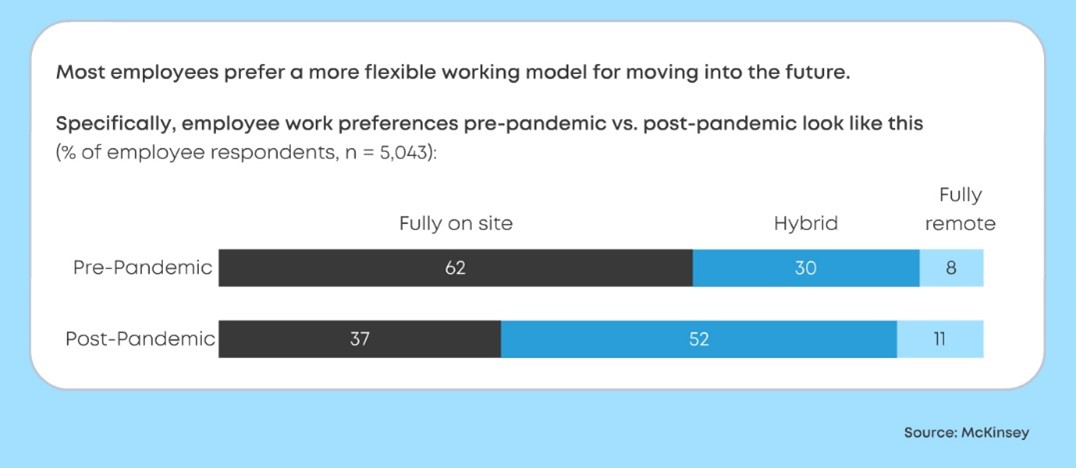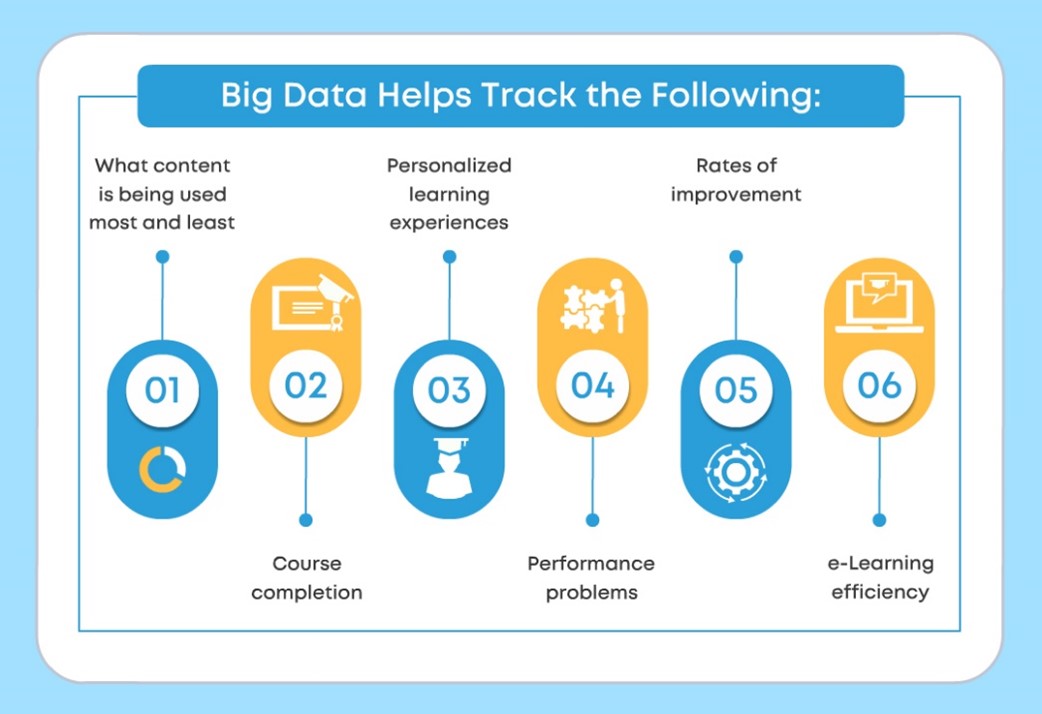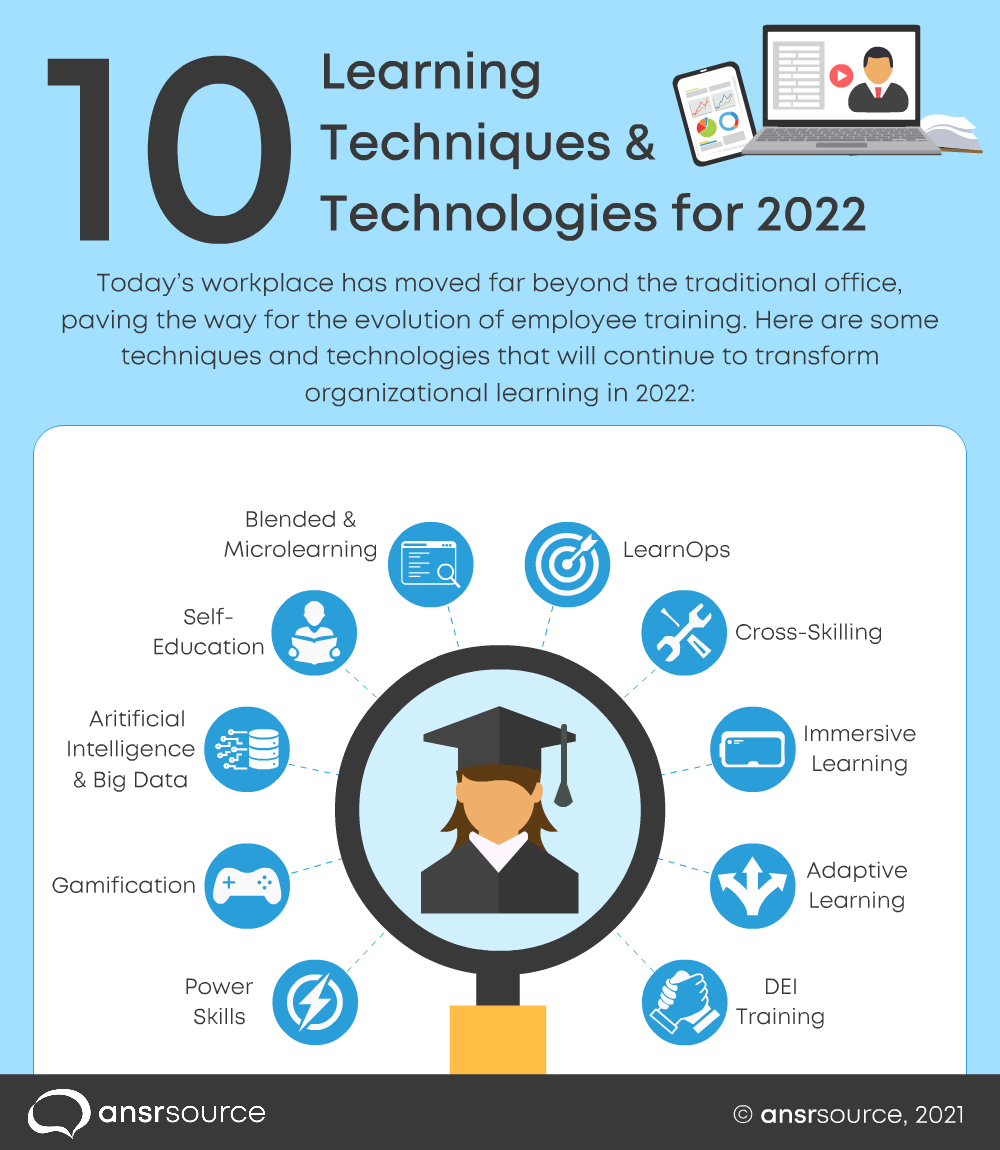Over the past few decades, employee training and learning has been in a constant state of evolution. From synchronous to asynchronous learning, the L&D industry has been changing, with technology transforming traditional learning and making employee training more engaging and measurable.
The last couple of years have been particularly challenging for organizations to adapt and deliver effective training. The uncertainty caused by the pandemic has pushed many organizations to close offices and move to flexible schedules. This has presented training and learning challenges for both the organizations and the workforce. While we continue to deal with these uncertainties, here are some major trends that will shape organizational learning in the coming year.
10 Technologies and Techniques That Will Shape Organizational Learning in 2022
1. Blended and Microlearning:
Most organizations have employees working in new ways—remote, hybrid, on-site, or some combination of these. With no end in sight for the pandemic, employees too have embraced flexible working. A McKinsey survey on the future of the workforce revealed that:

This means that L&D departments will need to find new ways to deliver training to a workforce that is geographically distributed. Here are some methods L&D departments can use to meet this new requirement:
- Create more on-demand training
- Make courses interactive and focus on engagement
- Establish frameworks for goals and results
- Embrace technology for learning
One trend that has emerged as a popular solution is microlearning. Microlearning refers to bite-sized learning that can be consumed from anywhere. As per Meridian, employees, on average, have only about 1% of their time to dedicate to professional development during their 40-hour workweek. In-depth content consumption is a real challenge and is not practical for employees. This is where microlearning comes in. Microlearning breaks information into smaller nuggets that require less time to consume and can be spaced out over a day or a week. Microlearning is a powerful corporate training tool for a couple of reasons:
- It makes learning accessible for all learners
- Microlearning courses can be delivered anywhere to any device
These advantages are accelerating the adoption of microlearning within the L&D framework. We will see more businesses and corporations adopting microlearning in 2022.
2. LearnOps:
A 2020 study conducted by ATD analyzed the most common barriers to the faster production of training and found three main barriers:
This means that L&D departments will need to find new ways to deliver training to a workforce that is geographically distributed. Here are some methods L&D departments can use to meet this new requirement:
- Limited resources
- Scope creep
- Lack of standardized processes or templates
Barriers like these hinder the training process and result in missed deadlines and opportunities which, in turn, impact organizational performance. LearnOps helps mitigate silos between departments and enables them to work together seamlessly. LearnOps consolidates the efforts, insights, and responsibilities of the multiple areas of the learning lifecycle so that all cogs in the wheel move seamlessly. Implementing LearnOps within L&D departments can produce better learning outcomes by:
- Identifying friction between stakeholders, designers, and project managers
- Providing valuable data on learner needs and preferences
- Streamlining the learning technology stack
- Aligning L&D more closely with organizational goals and objectives
3. Cross-Skilling:
Cross-skilling refers to the learning of new skills that can be lent to different areas within an organization to facilitate more collaboration and support. For example, the CEO of the award-winning design firm IDEO, Tim Brown, focuses on the creation of what are known as “T-shaped” employees in his companies. T-shaped employees are those who have expertise in one aspect of the company (which makes up the leg of the “T”) while having a general working understanding of another aspect of the company (which makes up the arm of the “T”).
A McKinsey survey revealed that by the year 2030, with the rise in automation and other digital technologies, as many as 375 million workers globally will need to learn new skills. This directly implies the need for rapid upskilling and cross-skilling to develop a more capable workforce. Cross-skilling will be increasingly adopted by L&D departments in 2022 and beyond because it:
- Enables better collaboration
- Increases workforce sustainability
- Improves efficiency
- Makes the organization agile
- Improves employee motivation
4. Immersive Learning:
Immersive learning, a contemporary learning style, engages with the learner’s senses through the use of technology, something that a traditional lecture or training session will not be able to accomplish. Immersive technologies, such as Extended Reality (ER), Virtual Reality (VR), and Augmented Reality (AR), have the potential to transform the e-learning landscape. Though these technologies are still at a nascent stage, the results they can deliver are promising. The use of immersive technology in training will continue to grow because it benefits the learner in many ways, including:
- Increasing engagement
- Catering to the learner’s preferred style of learning
- Making information memorable
- Allowing the learner to control the learning experience
5. Adaptive Learning:
Adaptive learning is learning that adapts to the learner’s progress, needs, and requirements. In the last few years, the idea of adaptive learning has gained momentum within organizations. This is primarily due to new product developments, partnerships between e-learning software providers and education publishers, and significant investments from institutions and government bodies.
A good example to understand adaptive learning is to look at the World Wildlife Fund (WWF). Their team is dispersed and has members across the globe. They decided to implement adaptive learning to quicken the onboarding process and provide customized training solutions based on each learner’s needs and requirements. The e-learning course they created replaced a webinar (which was about 1.5 hours long) with a self-service interactive training (which is about 45 minutes long), thereby allowing their employees to focus on areas of greater interest and need.
Adaptive learning will continue to increase in prominence over the next decade.
6. DEI Training:
Diversity, Equity, and Inclusion (DEI) is a term that describes policies and programs that encourage the participation and representation of diverse groups of people, including:
- People of different races, genders, and identities
- People of different abilities and disabilities
- People from different cultures and religions
- People of different sexual orientations and ages
- People with diverse backgrounds, skills, and experiences
L&D departments within organizations are looking to ensure that their workforce is trained and coached on all aspects of DEI to build a more compassionate and empathetic workforce. DEI training and initiatives are also seen as a competitive advantage in the workplace. Several of the leading organizations in the world are mindful of this. For example, research carried out for Forbes Insights’ report Global Diversity and Inclusion: Fostering Innovation through a Diverse Workforce revealed that close to 85% of the companies that were surveyed with more than $500 million in revenue either agreed or strongly agreed that “a diverse and inclusive workforce is crucial to encouraging different ideas and perspectives that drive innovation.”
7 Power Skills:
Marti Konstant, a workforce futurist and consultant, published an article on LinkedIn that drew a lot of attention as it articulated the “seven most requested power skills in a complex COVID workplace.” These power skills include:
- Creativity
- Adaptability
- Communication
- Emotional intelligence
- Leadership
- Collaboration
- Time-management
Power skills are forever skills. They relate to how you work, not to what work you do. They are behavioral in nature and are considered more valuable than technical skills. As we continue to embrace a hybrid working environment, behavioral skills will be more and more crucial. The next few years will see L&D departments including training that can help develop these skills.
8. Gamification:
Gamification in e-learning uses interactive game mechanics to boost information retention rates and drive learner engagement. A 2019 study by TalentLMS revealed that:
- Gamification made employees feel more productive and happier at work (86%)
- 83% of those who received gamified training felt motivated, while 65% of those who received non-gamified training felt bored and unproductive
- 78% of the respondents said that gamification in the recruitment process would make the company more desirable Gamification in corporate learning will continue to grow as it:
- Increases motivation and engagement
- Can facilitate complex learning problems
- Makes learning fun and interactive
9. Artificial Intelligence (AI) and Big Data:
AI has been a growing trend in the e-learning space for some time now and has the potential to transform the whole realm of online learning. AI has already made noteworthy headway in continuous learning and contextual support. AI-powered tools and technologies collect data, such as learners’ strengths, interests, and weaknesses, and deliver learning solutions customized for each learner. Listed below are some advantages experienced by organizations that have adopted AI-based learning tools:
- Improved learning efficiencies
- Customized learning tracks for employees
- Higher completion rates
- Scaled training content building
- Data to measure training effectiveness
AI in learning will only continue to grow in the coming years. Automation, combined with data insights, has the ability to transform the entire learning industry. Big data has been around for a few years, but its application to the learning industry is exciting. Big data in learning involves the power that comes with utilizing the data accumulated through systems to prompt insightful decisions. By gathering and analyzing data, organizations can customize training to meet the unique needs of their learners. Big data is being used by the learning industry to analyze learning in a process known as Learning Analytics (LA). The different use cases for big data in learning are highlighted in the illustration below:

While it may take a while for the AI and big data trend to integrate completely with L&D departments in organizations, when implemented, it will have an instantaneous and positive effect on prediction, decision-making, and workforce development.
10. Self-Education:
It is estimated that Gen Z will make up 30% of the U.S. workforce by 2030. There are certain traits that distinguish Gen Z (especially those entering the workforce) from the previous generations, like:
- They are digital natives; they grew up with technology and the Internet
- They are more racially and ethnically diverse
- They are on track to be more educated
Gen Z also has different training and learning preferences. They prefer to learn through:
- Observing
- Acquiring new skills continuously
- Mentorship
- Self-paced education
As more of Gen Z continues to enter the workforce, L&D departments will need to adopt new ways of training this workforce. They will need to facilitate continuous on-demand learning that can be completed from anywhere.
A lot is written and discussed about the “Great Resignation”. This refers to an idea proposed by Anthony Kloz, a professor at Texas A&M University, predicting a large number of people leaving the workforce after the pandemic ends and life returns to “normal.” This trend can be attributed to people searching for something more meaningful and, with the work-from-home culture, looking for a better work-life balance. Organizations and L&D departments will have to find ways to navigate this trend and be prepared to upskill, reskill, and cross-skill their workforce so that they are not caught unprepared. Incorporating the trends mentioned above into training programs can help progressive organizations stay ahead of the curve




